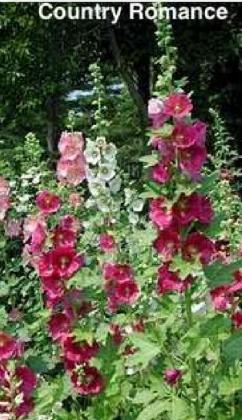Summer time always reminds me of hollyhocks (Alcea rosea) blooming in the garden and dolls made out of the flowers and buds. In New Mexico almost every old picture of Santa Fe has hollyhocks blooming in front of an adobe house or wall. But where did the hollyhock originate? Did they come from England? I remember pictures of English Cottages with hollyhocks adorning the gardens. Looking into history shows they came from farther shores. Origins point to Japan because hollyhocks have a long history in their culture. Travelers spread the hollyhock across Asia and eventually they were found in the Middle East. The English encountered them during the Crusades and brought them back to England where they thrived.
The hollyhock plant was used to make a salve that was very good for the Crusader’s horses which were injured on their hind legs, or “hocks”. This is where the name comes from: holly as is holy (the Holy Land) and hock as in the part of the horse treated with the plant.
All parts of the hollyhock plant have been used for natural remedies for centuries. It is chemically related the common marshmallow and can be used as a poultice for wounds and rashes. Hollyhocks were also used as a tincture in expectorants, and for diseases of the circulatory, gastrointestinal, respiratory, and urinary systems. For meals, a tea can be made from the flowers and leaves. They can also be used in salads and soups. Hollyhocks are also well-known as dye plants. All colors except black will make a yellow dye. The blackflowered hollyhock is an heirloom grown by Thomas Jefferson at Monticello. In 19th century Germany it was used to color wine. Black flowers yield anything from pale lavender to dark purple dye. The Hollyhock symbolizes the circle of life, ambition, fertility, and abundance and were planted at the front door to encourage those attributes.
The hollyhock spread so widely because of its ability to thrive in almost any climate and soil as long as it is planted in full sun. It is known for growing in cracks of sidewalks and will grow in soil from clay to sand, acid to alkaline. Their wide range of colors make for an attractive background of pinks, reds, whites, purples, and black. You can also find them with double blossoms or dark centers. They can grow as tall as 10 feet or a miniature as short as 18 inches.
In New Mexico many people find it hard to grow the hollyhock from seed. One trick that seems to work is to buy a hollyhock plant. The seeds that drop from the plant often work germinate where a scattering of seed fails.
Hollyhocks are part of the Mallow family, a very disjointed branch of the plant world that contains: okra, cotton, hibiscus, and marsh mallow. Hollyhocks are biannial meaning they will grow a rosette the first year and flower the second year. They grow in USDA Zones three to , bloom June to August.
Hollyhock seeds can be started indoors in early spring or outdoors 1 week before the last expected frost. Keep the soil moist during this time but expect erratic germination. Because hollyhocks get so tall, protection from high winds with a fence, wall, or stake will keep them upright. They are prone to rust that will weaken them. Water from below, good air circulation and a thorough fall cleanup will help. If you see yellow leaves remove and dispose of them to prevent further spread.
Hollyhocks feel like such an important part of summertime memories that is seems a shame not to have a corner of the garden dedicated to the highly useful and beautiful flower.
Edith Iwan is a Cibola-McKinley County Master Gardener who lives and works in Thoreau. As a Master Gardener she assists the County Cooperative Extension Service in providing accurate, research-based gardening information to county residents. If you have any gardening questions, please call the NMSU Cibola County Extension at 505-287-9266 or NMSU McKinley County Extension at 505-863-3432

